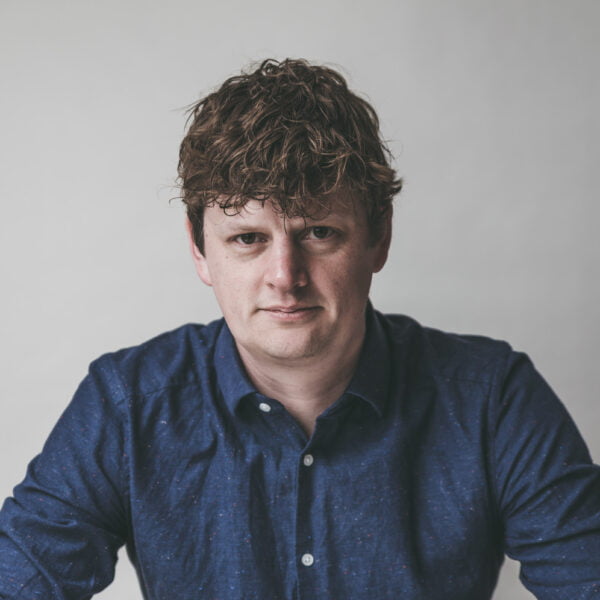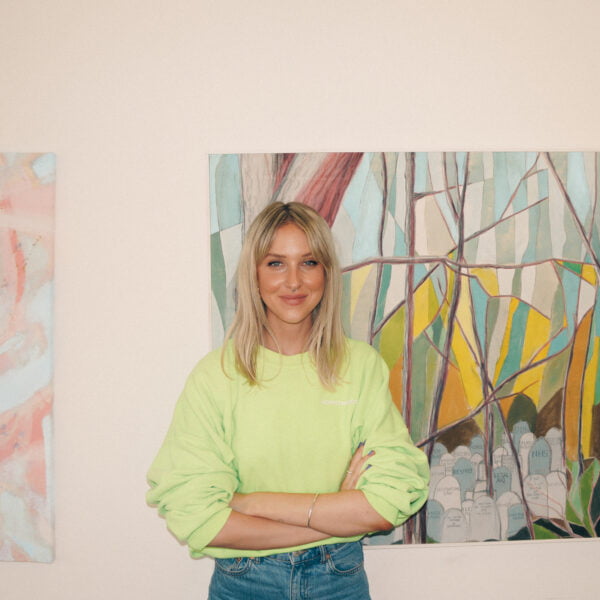
Natasha Collie
Senior Brand Marketing Manager at Penguin Random House UK
At the start of the year, Ladybird Books approached Sonder & Tell with a dream brief. In 2021, a year that’s been particularly challenging for...
In conversation with
Writer & Curator

Occupying the space between fashion and art, writing and culture, Lou Stoppard has carved a career out of examining the beauty of life’s finer details.
Since her early days working for award-winning fashion website SHOWStudio, Lou has deftly moved between journalist and cultural critic; curator and editor.
You may have seen her name inked beneath various New Yorker articles – notably a personal essay which regaled her love of the Ladies Pond in winter – and most recently she has edited her second book with Rizzoli, Pools, in which she explores lounging, diving, floating and dreaming at the swimming pool.
We spoke to Lou about her love of swimming, what makes a great fashion writer and the creative partnerships she’s learned from.
I loved all kinds of stories as a child, and channeled those interests into all kinds of odd activities. I was obsessed with dressing up, for example, but the characters I chose were quite eccentric for a small child – Eliza Doolittle at the races in My Fair Lady is a good example. I loved reading and tended to pick things far too advanced for my age and abilities. I tried to read Little Women when about 8. It took a year and went totally over my head but I did it (if you count bemusedly scanning pages as reading!).
Working at SHOWstudio was such a great experience and a part of me misses the team work and the constant excitement of working with Nick every day. I was just a term into my masters at Central Saint Martins when Nick hired me and, in most people’s eyes, very inexperienced, but Nick saw something in me. He has an amazing eye for spotting talent. He gave editors Penny Martin and Alexander Fury their first big breaks and photographers such as Solve Sundsbo and Craig McDean are his former assistants. So many people in the fashion industry owe their career to him, me being one of them. I definitely learnt on the job. In many ways, I think my interviews benefitted from the format; SHOWstudio’s interviews are live and often long (Kanye was about 2 hours, I think), so I never felt the pressure to get some great 5 second soundbite. I came to realize that what I was looking for with each interview was something new from the interviewee – a moment’s vulnerability, or a new opinion on something, or even a mannerism that felt candid. A lot of the people I interviewed were quite high profile so I was aware they’d spoken a lot about themselves in the past – so what I always tried to avoid was settling for entirely regurgitated material.
That’s a good question. To be honest it changes all the time – I’ve been lucky to write for places such as the FT and The New Yorker where I’ve had the chance to write about topics beyond fashion. I tend to be attracted to eccentric people doing eccentric things passionately (maybe that loosely unites Love Island and cold water swimming). One of the things that I actually learnt when I was at SHOWstudio was that it wasn’t really the clothes that excited me about fashion but the socio-political undertones of it, and the images, so I’ve enjoyed exploring ways to write about that. I love writing for Aperture magazine for that reason – it’s wonderful to write about photography with the urgency that their editors encourage.


Some people hate the idea of having to justify fashion to people – which I understand, as people are often very dismissive of it in this sort of vaguely sexist way that presumes it’s all vapid women when actually it’s a huge employer and a great cultural force – but I do tend to find it helpful to imagine how the article could be interesting to someone who had no knowledge or conscious interest in fashion.
There are a lot I admire. I read Holly Brubach’s A Dedicated Follower of Fashion when I was quite young and I think that that has probably had a big impact. I think Michael Roberts’ stuff was great. I also think Vanessa Friedman is always on point. Some of Jia Tolentino’s stuff for The New Yorker is great on wider consumer culture and branding – for example, her piece on Outdoor Voices and athleisure was great. And Lauren Collin’s New Yorker profile of Donatella Versace, which is years old, is brilliant.
I am something of an obsessive swimmer. As a teenager, I was a competitive swimmer, so I got used to spending evenings and weekends at the pool. I write about this in the book; “I trained myself to respond instantly to the sound of the gun––I learnt never to dawdle. I learned the strange body arcs required of butterfly, the flicks of the tumble-turns, the fearlessness needed to keep on holding your breath, just for one more stroke, one more reach, one more second.” When I went to university, I stopped swimming entirely and I didn’t get back into the pool for years. I started to notice that I’d become slightly fearful of water. I felt anxious in the deep end, and very aware of other forms or shadows. I have a very overactive imagination, so I managed to picture all kinds of horrible things. I knew I wanted to cure that fear – so I started swimming constantly. Lakes, rivers, ponds, pools – I’d get in. Now I swim whenever I can.
I’ve wanted to do this book on the pool in photography and the creative imagination for years, so I’ve been collecting great pool photographs for a very long time. In a way, you are hard-pressed to find a photographer who hasn’t made a pool image, at some point, at some time. And so many photographers have made really great pool images – famous images, that we all know and love. Stephen Shore and Guy Bourdin are just two good examples of that. I knew that I wanted a real mix of photographers (young, old, celebrated, unknown) and also a mix of styles and genres, from fashion through to documentary.
Part of this was to show the way that the swimming pool has remained a seductive place for photographers, as years have passed – it sounds negative to call it a trope, but in a way, it is. Pool pictures litter the history of photography. It would have been easy to organise the book chronologically or by photographer, but I wanted to do something a bit weirder, something that really captures the joy of swimming, and spoke of the myriad ways water can make you feel. So in the end the book is organised around moods of swimming, and photographs are grouped that way; Meditation, Glamour, Coming of Age, Holiday, Sex, and so on. That way, we could look at different ways the pool can be seen – as a backdrop for subplots (pool parties, style, sex) or as a state of mind, or even a set of angles and lines. Each chapter starts with a quote from a great swimming scene in literature that echoes the mood of the images. It’s a nice wandering bibliography; a reading list for people to go away and work through. They are taken from a range of books and stories – The Great Gatsby, Cassandra at the Wedding, The Line of Beauty, and, of course, The Swimmer by John Cheever; “The day was beautiful and it seemed to him that a long swim might enlarge and celebrate its beauty.”

I actually really enjoy working collaboratively, which is ironic, given I’ve chosen the solitary life of a writer! A few years ago, I co-curated an exhibition about the influence of the North of England on fashion and visual culture, and I so enjoyed collaborating with my co-curator Adam Murray. The exhibition opened at Open Eye Gallery in Liverpool and toured to Somerset House in London and later The Civic in Barnsley, and we also released a corresponding book, so Adam and I worked super closely for a few years. You learn so much when working with someone else – it hugely expanded my knowledge and made me think about the topic in ways I wouldn’t have done. Last year, I curated an exhibition at Het Nieuwe Instituut, Rotterdam, on The Hoodie. Obviously, that is a garment with a rich and difficult cultural and political background, and I must say I missed working with someone else – curating that solo was enjoyable but tough, I think at points I missed having someone to bounce ideas off, someone to challenge my personal habits of thinking and suggest things I might have dismissed or overlooked.
Read.
I reread Sam Knight’s New Yorker profile of Ronnie O’Sullivan about once a month. To me, it’s perfection – the subject, and the writing.
Recently, I adored Ben Lerner’s The Topeka School. I found the way it challenged the format of a novel so exciting. That answer is a cliché as that book has got so much praise, but I adored it. I also recently read I Chose Elena by Lucia Osborne-Crowley – it’s about pain and trauma and reading and it is just so so brilliant. She has a way of writing that is so personal but that also feels supportive, like a good talk with an old friend – that book made me feel seen.
Lou's Storylist

Senior Brand Marketing Manager at Penguin Random House UK
At the start of the year, Ladybird Books approached Sonder & Tell with a dream brief. In 2021, a year that’s been particularly challenging for...

Founder Of Simple Politics
Talking about serious issues doesn’t mean defaulting into a serious tone of voice, or using complicated language. If anything, accessibility, clarity and a touch of...

Brand & Community Manager at Homethings
Creating a tone of voice from scratch can be challenging. But a blank slate to work from also mean there’s room for something a bit...

Co-Founders Of Duzi Studio

Director of Communications at Harts Group